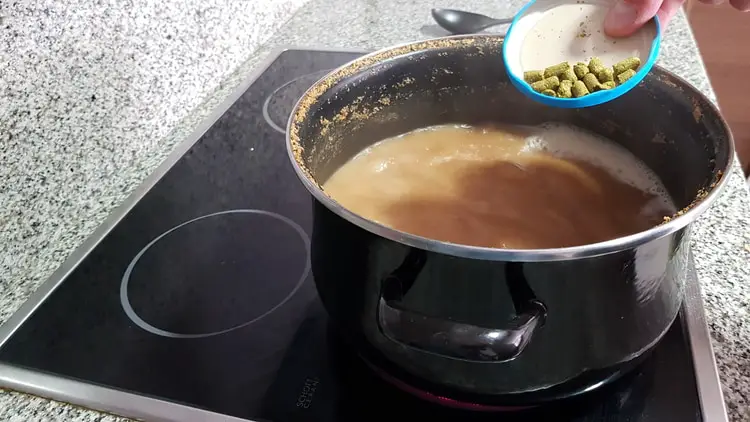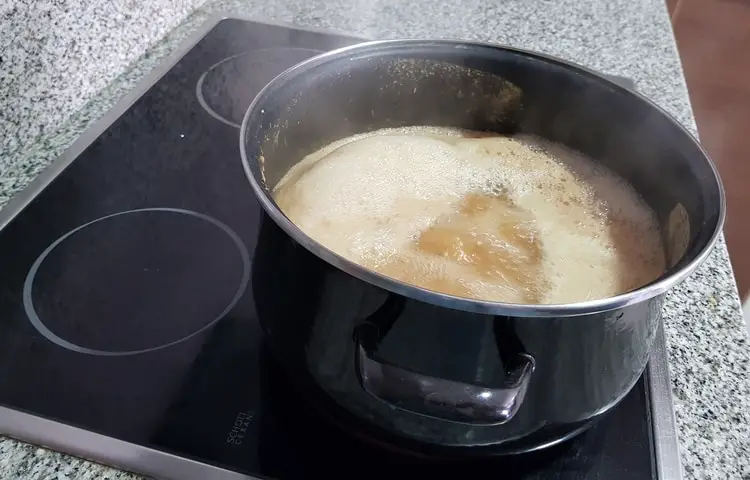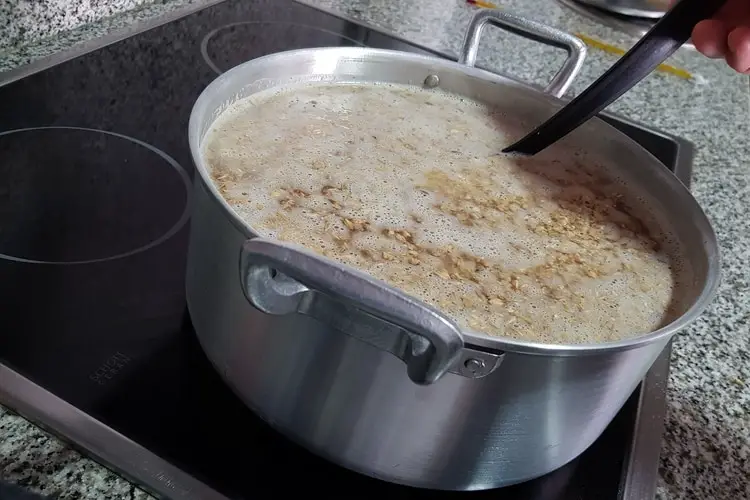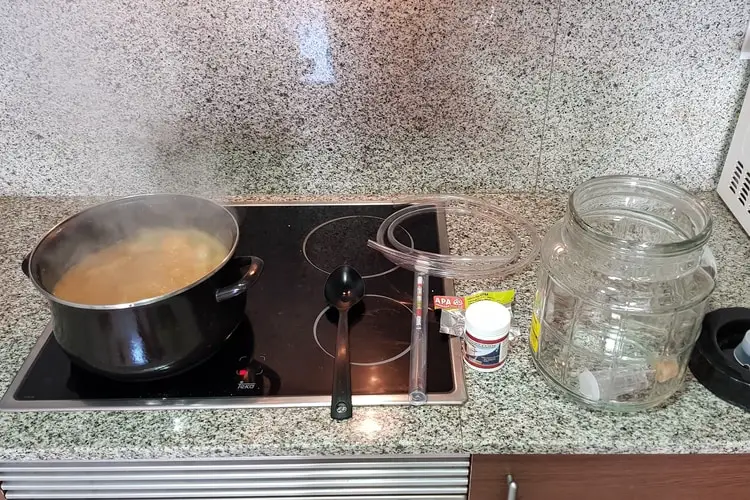Brewing with an electric stove is not the preferred method of making homebrew, but it is definitely doable and can even be an advantage with smaller batches of beer. If you enjoy brewing, being able to brew on an electric stovetop gives you the freedom to brew year-round without interference from the elements. But how does it work?
There are several pros and cons to brewing beer on an electric stove or burner versus brewing beer in a traditional boiler setup. The following chart outlines some of these advantages and disadvantages:
| PROS | CONS |
| Excellent system control | You may need to install a new circuit |
| Convenient setup and operation | Inefficient boiling method |
| Lower risk of carbon monoxide poisoning | Condensation challenges |
| Ideal for small batches | Cannot manage larger batches |
| No additional costs to set up a boiler | Requires stovetop access for extended periods |
Since there are many advantages and disadvantages of brewing on an electric stovetop or burner, brewers should weigh these options carefully before deciding to try a stovetop brew.
Keep reading to learn more about electric stove brewing and how to do it more easily to ensure a fun and hassle-free experience on your next batch.
Can You Brew Beer on an Electric Stove?
The answer is yes! Brewing on an electric stove comes with some constraints and conditions, but it is doable, especially for smaller or experimental batches of beer and extract brewing methods.
For would-be brewers who would like to make beer but cannot afford a full propane boiler setup, never fear!
You can still make beer if you have an electric household stove and the inclination to try it out.

Advantages of Brewing Beer on an Electric Stove
While most people don’t consider an electric stovetop as their go-to for brewing beer, if they’ve been brewing for an extended amount of time, it’s a good option for novices getting started if you don’t have all the necessary brewing equipment gathered up yet.
Here are some of the pros of using an electric stove for brewing beer:
- Excellent system control: Electric home brewing can be useful because it gives precise control of the heating system. Making sure that the strike, match, and boil are consistent from one batch to another is much easier on an electric stove than on a propane boiler setup, where temperature fluctuations can have a significant impact on flavor. The amount of time wort spends on the heat does not matter nearly as much as the specific temperature it heats at.
- Convenient setup and operation: Electric stoves serve as an excellent alternative to traditional propane setups for convenience. Because electric stovetops are often situated near a kitchen sink and cabinet storage, there is easy access to all the ingredients and equipment necessary to brew a batch of beer in one place. Electric stoves are silent, efficient, and don’t require propane gas, which means they are safe to use all year long.
- Lower risk of carbon monoxide poisoning: One of the most considerable risks involved with using a propane boiler to brew beer is carbon monoxide, especially if you’re brewing in an area where there’s little to no ventilation, such as an enclosed garage. This is not the case with electric stoves—not only do they not produce carbon monoxide, but they also usually come with a hood fan to provide proper ventilation.
- Ideal for small or multiple batches: One major advantage of electric stovetop brewing versus propane brewing setups is that you can get started much more easily if you are trying to brew a micro-batch (five gallons or less). For extract beers or other experimental brews, electric stovetop brewing can give you an option to go smaller for your entire brewing operation and can even let you heat wort on two separate batches simultaneously.
- No additional costs for a boiler: For novices who want to get involved in homebrewing without throwing down hundreds of dollars to pay for the chance, using an electric stovetop to brew beer can significantly decrease the overall start-up costs of a homebrewing enterprise. A good propane boiler setup is often one of the most expensive parts of a brewing kit.
Even though it is not the first option chosen by many brewers, brewing on an electric stovetop or burner brings plenty of benefits to the table.
If you are just getting started in brewing and want to start small, electric brewing might be a good option for you.
Disadvantages of Brewing Beer on an Electric Stove
While brewing on an electric stovetop or burn has its advantages, there are some notable drawbacks to using this method for brewing, as well.
Here are some of the disadvantages of brewing beer on an electric stove versus using a traditional propane setup:
- Your circuitry may not be able to handle it: When you are considering a shift to electric home brewing, you will need to look into your wiring. Some electric circuits cannot handle the power necessary for homebrew. To use your electric stovetop, it needs a Ground Fault Circuit Interrupter (GFCI) outlet. These are outlets with small rest or reset buttons installed. You may also need a GFCI breaker to ensure necessary amperage.
- Inefficient boiling: Compared to a propane boiler, an electric stovetop can take much longer to achieve a proper boiling temperature, increasing the amount of time necessary for the overall homebrew. Depending on the amount of wort being boiled, the time it takes to bring the wort up to proper temperature may cause fluctuations that will affect the end flavor of the beer. This is especially a problem for anyone trying to brew more than five gallons of beer at a time.
- Condensation challenges: Condensation can be a serious problem with electric brewing, especially if it is being done in a location with minimal ventilation. If there is no proper ventilation in your brewing space, you may deal with issues like mold and water damage. This is not a problem that can be solved with air conditioning or dehumidifiers, either. For large scale brewing systems, it may be necessary to invest in a range hood or condensation hood.
- Cannot manage larger batches: If you want to do a large batch of your signature beer, an electric stovetop is not the way to go about it. Most stovetop setups simply cannot heat a container large enough to hold larger batches of beer because the stovetop burner space isn’t adequate. You will have a tough time boiling a batch of beer larger than five gallons maximum on an electric brewing setup.
- Requires stovetop access for long periods: Not only does it take longer to brew beer on an electric setup effectively, but it also requires you to give up the use of your cooking stove for long hours. Want to cook dinner and brew a batch of beer? Forget about it if you are using your electric stovetop as a boiler because it is going to be awhile.
There are several downsides to using an electric stovetop for brewing beer, but thankfully some of them can be mitigated as long as you have the right equipment.
Can You Get a Rolling Boil on Five or Six Gallons of Wort?
While it might take longer to get going than a propane setup, the answer is yes—you can get a strong rolling boil going in five or six gallons of wort on an electric stovetop.
There are a few extra steps you may need to take to get the temperature of the stovetop up, such as insulating with aluminum or other measures, but achieving a rolling boil on an electric burner can be done.

Should Wort Be Boiled Quickly?
The biggest concern with using an electric stovetop to brew beer is maintaining proper temperature, not getting to it.
If you keep your mash boil under twenty-four hours to prevent souring or other spoilage of the grains, mash and wort can be heated for many hours without causing a problem with the flavors in the beer.
The length of boiling time most strongly affects the gravity of a beer.
Beers that have been boiled longer end up with higher specific gravity, which results in more fermentable sugars and a higher alcohol-by-volume content for the resulting beer.
It is also crucial that the wort is cooled down adequately before being pitched or having yeast added to ferment the sugar in the wort.
If the wort is not allowed to cool down enough, it will kill most or all the yeast added, resulting in a beer that is cloying and low in alcohol content.
How to Make Wort Boil Faster on an Electric Stove
It may be harder to get your wort up to a boil on an electric stove versus a propane brewing setup, but that does not mean that it is not possible.
It may just take a little bit of improvising and some additional equipment to make sure the task can be done efficiently and without overloading the electric stovetop.
Here are some tips on how to make your wort boil faster using an electric stovetop or burner:
- Do a split boil. Instead of trying to boil your entire volume of wort on one burner in one pot, try splitting the batch into two pots for the boiling part of the brewing process. There are a few more challenges with making sure that all the wort chills down consistently by using this method, but it can help get the most use out of less powerful electric ranges.
- Use an immersion or bucket heater. An immersion heater can help take some of the pressure off of your electric burner to maintain the temperatures for a rolling boil. Be careful to use immersion heaters carefully and per the manufacturer’s instructions to avoid starting a fire.
- Start with hot water. If you start your wort boil with cold water, it is going to take much longer to get up to the temperature you need than you would have to wait if you started with water that was hot from the tap.
- Cover the pot. A covered pot boils much more quickly than a pot without a cover, and you will end up losing less of your wort to evaporation. However, be careful that the cover on your pot does not lead to a boil-over. Care should be taken to observe the brew at this stage in the game to prevent a catastrophe.
- Insulate with aluminum foil. Insulating the sides and bottom of your wort boiling pot with heavy-duty aluminum foil can help ensure that less heat escapes from the boiler through the ambient air, allowing it to gain heat more quickly and maintain it more easily.
If you have a hard time getting your electric stovetop up to adequate boiling temperatures for a batch of homebrew, try some of the above tips, and you will likely have a much easier time getting the temperatures you need for your brewing project.
When to Pick an Electric Boiler over an Electric Stove
So, you want to use an electric range for cooking your homebrew to avoid having to use gas, but you do not want to dedicate your entire working kitchen to do it.
The good news is that there are plenty of electric boilers on the market that allow you to boil your beer on electric heat without taking up crucial surface area on your kitchen’s range or countertops.
Choosing an electric boiler is a good option for when you’d rather not have to work with propane, but you also don’t want to use your kitchen for brewing or don’t think that your kitchen stovetop will be able to conduct enough electricity to manage it.
Electric boilers present the best of both worlds—they can be conveniently located out of the high traffic areas of the household in a basement or garage, don’t require the use of propane that can lead to poisonous carbon monoxide build-up, and they are explicitly built for homebrewing as a portable standalone system, so you won’t have to dedicate any of your regular cooking space to use them.
Here are some of the electric brewing boilers available on the market:
No products found.
There are plenty of other types of propane boilers available to heat gas for conducting a beer boil more traditionally, but propane setups come with plenty of disadvantages.
If you are set on going electric for your brew but do not want to dedicate your kitchen’s stovetop to the project, an electric boiler is a perfect compromise.
Extract vs. All Grain: Which is Better for Electric Brewing and Why?

When it comes to sheer convenience and ease of brewing, doing a malt extract homebrew versus an all-grain brew is significantly easier if you are trying to conduct your boil on an electric stovetop or burner.
Here are some of the reasons why:
- Speed and volume: Not only is extract brewing faster, but it also takes up less room since you do not have to break down a mash of grains. Extract brewing, in general, is a better option for microbrews or small beer batches.
- Less equipment, less prep work: You need fewer tools to do an extract brew than an all-grain brew since you don’t have to worry about sparging and some of the other grain preparation steps, which adds both time and complication to the overall brewing project.
- Perfect for beginners: For people who are just getting started on their homebrew adventure, an extract brew presents fewer chances to commit a brew-ruining error into the proceedings and is an excellent choice for those who are still getting their feet under them when it comes to the brewing process.
There is, however, one major challenge you will face when using an extract—they tend to stick to the bottom of the pot.
To prevent this, stir the mixture continuously.
All-grain, on the other hand, is a more difficult brewing process with many more opportunities for operator error, especially if you are working in small batches.
There’s much more physical work involved since you will have to buy the whole grains, mill them, and push water through a mash before you even begin the brewing process.
Last update on 2025-10-28 / Affiliate links / Images from Amazon Product Advertising API

